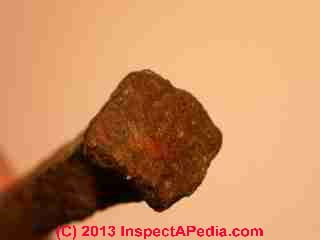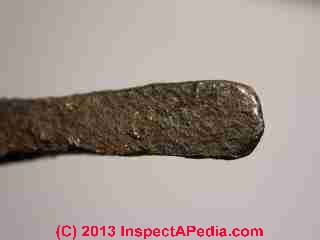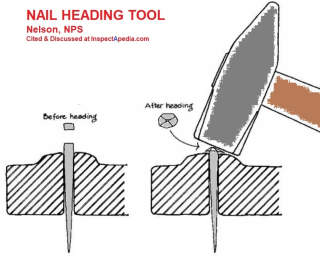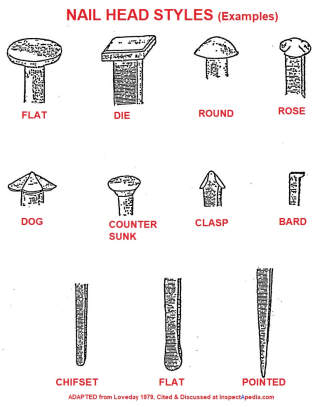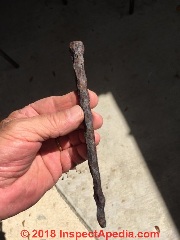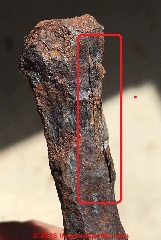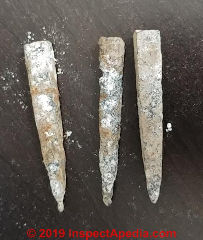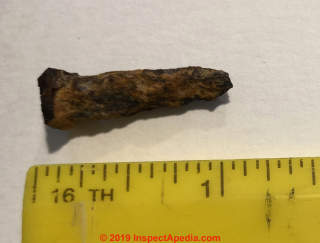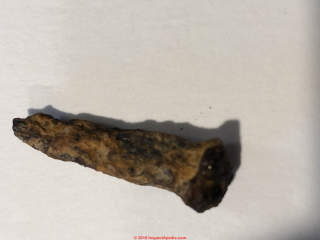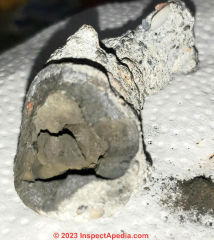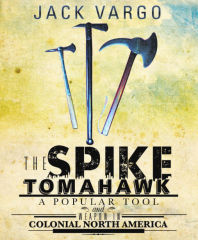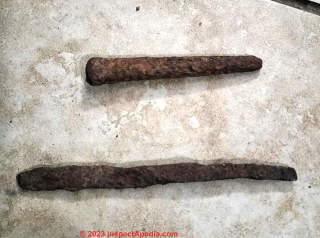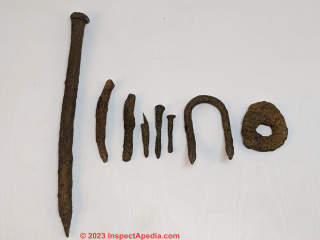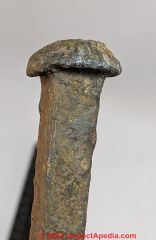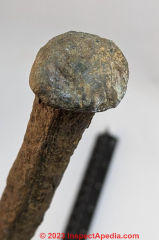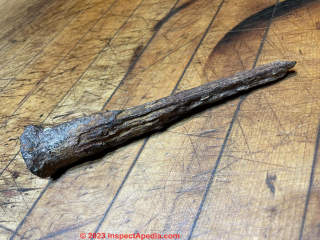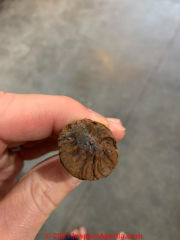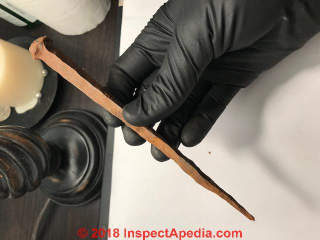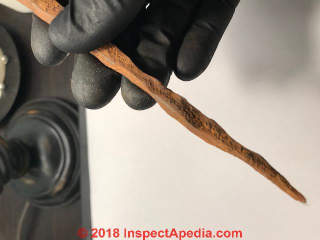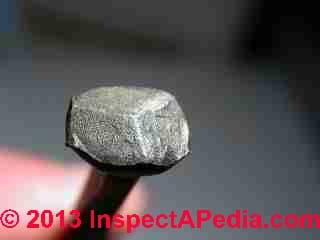 Hand-Wrought Nail Identification
Hand-Wrought Nail Identification
Key to the uses, property, history & age of hand-made nails
- POST a QUESTION or COMMENT about determining building age by examining its hardware
How to identify antique & modern reproductions of hand-wrought nails.
Page top photo: a dog headed nail identified by some sources as a rose-headed nail.
This article series describes and illustrates antique & modern hardware: door knobs, latches, hinges, window latches, hardware, nails & screws can help determine a building's age by noting how those parts were fabricated: by hand, by machine, by later generations of machine.
InspectAPedia tolerates no conflicts of interest. We have no relationship with advertisers, products, or services discussed at this website.
- Daniel Friedman, Publisher/Editor/Author - See WHO ARE WE?
Antique & Modern Hand-Wrought (Forged) Nail Identification Key
What is a forged or hand-wrought nail?
Forming wrought nails required both hard labor at a hot forge and also "semi-skill". Loveday (1979) points out that as a result the work was often left to slaves, at least in the Southern U.S. and sometimes to children.
At NAILS, AGE & HISTORY we point out that the history of metal nails dates from the third century A.D.
Historically the origins of nail making can be traced back to the Roman domination of Europe. Excavated Roman settlements in Germany and Great Britain have revealed nail making tools, dating from the third century A.D. (Loveday 1983)
Hand-wrought nails were used in North America in the 17th, 18th, and 19th century in American building construction.
Photo above: a "Die" type square head on a hand forged nail. [Click to enlarge any image]
This page helps identify the type of hand-wrought or cut nail or spike. You will want to pay special attention to your hand-wrought nail's
- Overall size: shank diameter and length
- Shape of the hand wrought nail head
- Shape of the hand wrought nail tip.
For information on cut nails (that text used to be on this page) see
NAIL ID & AGE: CUT NAILS - separate article. There you'll see that in the U.S. as early as the 1790s blacksmiths were using a machine to cut nails out of a sheet of plate iron. Those early nail-cutting machines, operated by hand, may have been used side-by-side in the blacksmith's shop where hand-wrought nails also continued to be produced for some uses.
Forged nails were and are made by hand by a blacksmith who produced hand-wrought nails by hammering on a rectangular "blank" or iron rod stock.
Wrought / Forged Nail Rod Slitting
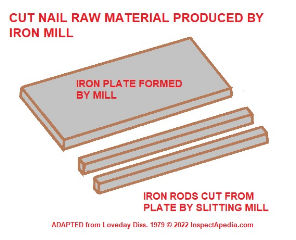 (Early hand-wrought nails were made from iron plate that had to be cut into slits to form nail "rods".
(Early hand-wrought nails were made from iron plate that had to be cut into slits to form nail "rods".
First flat iron stock was cut into strips in a process called slitting. These strips were often produced by a separate iron mill and sold to blacksmiths for forging into nails or spikes.
Above: to make cut nails, iron plate was cut into strips by a slitting mill to provide raw material for blacksmiths to forge into cut nails.
Notice that the nail rods or blanks are cut off of the iron plate and into uniform strips.
Forged Nail Pointing
At the blacksmith's forge the squared shank was heated red-hot, then hammered into a tapered shape, ever smaller towards what would become the nail's point or driven-end. The nail rod would be rotated one side at a time at each hammer blow.
The slits or nail rods were then pointed into one of the following point shapes:
- Four-sided point, all sides hammered roughly equally to a tapered point
- Two-faced point - two sides hammered to a point or an angled point (Chifset point)
- Bill or spade or "flat" point - the end of the nail is tapered to a wide flattened shape (shown below)
Forged Nail Cutting
The pointed nail rod would then be held over a pyramid-shaped iron hardy and hammered to cut off the pointed end of the rod to provide a nail of the desired length.
So you can see nails are being forged: pointed, cut, and finally headed, one at a time.
Forged Nail Heading
Holding the nail either in a nail heading tool (shown below, from Nelson) or by inserting the nail blank into a tube whose diameter was small-enough to cause a short length of the upper portion of the tapered nail to protrude. In this position the nail head was formed by additional hammering.
Nelson notes that the tapered shank allowed the nail to wedge into the opening in the heading tool, leaving a working length of nail to project above the surface of the tool. In place the top of the nail is heated again so that it can be hammered into the desired shape. The heading tool might be mounted onto a large anvil or the nail may be simply wedged into the handy hole that was pre-formed into a working area on many anvils. Nelson notes also that a similar method was used for heading early machine-cut nails.
Above: a nail heading tool as sketched in
Nelson, Lee H., NAIL CHRONOLOGY as an AID to DATING OLD BUILDINGS [PDF], U.S. National Park Service, Technical Leaflet No. 48. retrieved 2019/01/08, original source: npshistory.com/publications/nail-chronology.pdf
The blacksmith chose the nail's taper, point type, overall thickness and its head design depending on its intended use.
A horseshoe nail might be made quite thin, nearly flat, tapered, with a very sharp point that would be clipped and clinched over once driven through the horse-shoe into and through the edge of the horse's hoof.
But a nail to be used in timber framing would be much thicker, longer, tapered such that all four sides were the same, and finished with a much larger head.
Forged nails, unless badly rusted or filed smooth, will show hammer marks on their nail head and along the nail shank, and such nails will be a bit inconsistent or irregular with their siblings as each was formed individually, by hand.
There were at least eighteen nail head types in the early 1800's, possibly more in some locales. Loveday's illustration, shown below, itself is drawn from The Royal Engineer's Catalog of 1812 and illustrates eleven common forged nail head and point styles.
If your question is just about the age of an old nail or spike, see the key found
at NAIL AGE DETERMINATION KEY but remember that knowing the type of nail also helps identify its historic context or use and thus is also a clue to its age.
For a chronological history of types of nails from earliest time
Withdrawal-Resistant Hand-Wrought Spike
[Click to enlarge any image]
The interesting hand-wrought spike shown here, contributed by InspectApedia.com reader TL, was accompanied by these comments:
Found this in an old town in Florida while metal detecting. Any idea how old? Looks hand forged.
Found in Lake Helen, fl. Not to far from an 1880 Indian head penny and an 1899 barber dime so yes I believe it is a period piece without a doubt. I just thought it may have been older than that era.
The town was incorporated in 1888. But like I said I have items dating back to 1880 while metal detecting. - T.L. by private email 2018/10/11
Our OPINON: I agree that the spike looks hand forged, with the off-set dents and waves so regular as to appear deliberate, perhaps to create a spike with great withdrawal resistance.
It is certainly possible to make such a nail today, by hand, but the laminar splits near the nail head (marked in the red rectangle) suggest old iron, likely to have been forged before 1900. Sorry but I don't have a more precise dating suggestion.
The fact that the delaminating or split in this nail run lengthwise (parallel to the nail shank) suggest that the nail was of iron whose fibers ran lengthwise, making the nail one probably made after the late 1830s.
Compare these details to the machine made nail photographs throughout this article series including
Just above are details of the hand-wrought iron spike-nail that we retrieved from a post and beam structure framed before 1830 in New York's Hudson Valley.
A close examination of iron nails and spikes can quickly indicate whether the fastener was hand wrought or machine made, both by the irregularity of surfaces of the hand wrought nails and the presence of die-cut stamping marks on machine made nails.
Research on Hand Forged (Wrought) Nail History & Identification, Manufacture & Age
- ANCIENT ROMAN NAILS - more examples of hand-wrought or forged nails
- Bradley Smith, H.R., "Chronological Development of Nails," supplement to Blacksmiths and Farriers' Tools, Shelburne Museum (Shelburne, Vermont, 1966)
- Didsbury, J, "The French Method of Nail-Making," The Chronicle of the Early American lndustries Association, Inc., Vol. XII, No. 4 (December, 1959), 47-48.
P. 48 illustration of a nail-heading tool. - INVERNESS CANAL IRON TOOLS & SPIKES - discussion of iron artifacts found in the Inverness Canal, northern Scotland.
- Loveday, Amos J. The rise and decline of the American cut nail industry: A study of the interrelationships of technology, business organization, and management techniques. No. 53. Praeger, 1983. - and - Business Organization, and Management Techniques (Westport, CN: Greenwood Press, 1983)
- See our complete bibliography including more articles on the history & production of cut nails
at
NAILS & HARDWARE, AGE RESEARCH
How else might hammer marks be made on old nails of any sort? During reclamation and re-use of these valuable fasteners.
When our friend, Paul Galow, worked as an assistant to his uncle who built homes in Pennsylvania in the 1930's and 40's, his job was to salvage nails and hammer each bent one straight. Nails cost more than his labor.
...
Reader Comments, Questions & Answers About The Article Above
Below you will find questions and answers previously posted on this page at its page bottom reader comment box.
Reader Q&A - also see RECOMMENDED ARTICLES & FAQs
Question: can you tell me the age of these nails?
Any way to tell how old these nails are?
Reply: tips for estimating the age of sprigs or brads
Try gently wiping off the corrosion or efflorescence - that white stuff, then look for hammer marks on those headless nails - also known as "sprigs".
Sprig Nails or sprigs, generally from about 1/2" up to 2" in length, were used in trim, flooring, furniture, and in thin smaller dimensions in window or mirror glazing to hold the glass or mirror in place.
Sprigs were used where later brads (small round-headed nails) but would not have been used where the application relied on the head of a nail to hold something in place. Some texts use "sprig nail" and "brad" interchangeably. In my OPINION a brad has a head while a true sprig probably does not.
Some sprigs were cut with one side straight and at right angles to the head (actually headless but wider end of the sprig nail) but as your sprigs look tapered on both sides with a round center-widened taper I suspect these are hand made.
That wide center of your sprigs probably was designed to improve the nail's grasp or retention in wood, similar to its larger cousins, the clasp nail.
Sprigs were produced both by hand and later by nail making machines and appear in the U.S. (you didn't give a country for your nails) in hand-wrought form in the 17th, 18th, and 19th century American building construction.
I suspect you'll find hammer marks or file marks, or perhaps both and that would indicate an older pre-industrial nail.
Question: what can you tell us about this old nail fragment from Oshkosh WI?
My husband found this nail when digging for our property stake! I tried soaking it in equal parts of vinegar and hydrogen peroxide and salt to get the rust off!
This is the best it’s going to get! He said he’s sure this nail was hand made. Any information would be appreciated! A small piece of history
Thank You
Anonymous by private email 2019/08/26,
Oshkosh Wisconsin
Reply: a few easy questions help sort out the age and use of old nails
Anon: the photos are a bit blurry and the nail so corroded as to be limited in what it can tell us. But there may be at least one detail we can note here. And from the size you can rule out large building spikes or structural connectors.
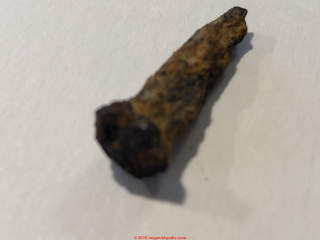 I'll post your photos and question here at NAIL TYPE, ANTIQUE, IDENTIFICATION KEY where perhaps other readers may have an opinion - posted as page-bottom comments.
I'll post your photos and question here at NAIL TYPE, ANTIQUE, IDENTIFICATION KEY where perhaps other readers may have an opinion - posted as page-bottom comments.
Your photos and the nail condition are blurry and limited in information they provide, but I notice in one of the photos that the head of the nail is awfully precisely square - possibly arguing for a machine process.
When we don't know more about a nail or screw and want to guess its age it's helpful to note the following:
- Country, city, and details of local environment where found
- Context of the find: old building? of what age, type, use; ship, cart, building component (door, window, trim, roof, siding, etc) - often hinted-at by surrounding wood fragments
- Close-up magnified, even stereo-microscopic examination of nail details that can give cut lines (the article above translates cut nail marks to give age ranges), hammer marks, etc.
Look also for directions of grain in the iron - split directions and compare those with the companion article
at NAILS & HARDWARE, AGE. /interiors/Nails_Hardware_Age.php
On 2023-05-24 by Irv - hand wrought, square shank with an offset rose bud style head found in Caribbean
@InspectApedia DF, Thank you for the quick reply! Based on my limited research and the information you provided, I am confident the nail is pre-1839 however, as it has not been completely exposed from the concretion, I am unable to confirm an accurate size and configuration of the shaft etc. Photo attached
On 2023-05-24 by InspectApedia DF (mod)
@Irv,
You will find our most complete advice on guessing age at
NAIL AGE DETERMINATION KEY
https://inspectapedia.com/interiors/Determine-age-of-old-nails.php
where you'll read about details of the nail itself as well as using contextual clues to learn more about it.
Try adding a photo using the Add Image button and we can take a look as well.
On 2023-05-24 by Irv
I am seeking help in identifying and aging an artifact which I found, while snorkeling in the Caribbean. It is a stand alone nail approx 4" long, which has been completely preserved in a concretion. I have since exposed the head of the nail which appears to be hand wrought, square shank with an offset rose bud style head. Any assistance is appreciated.
On 2023-03-30 by InspectApedia Editor - iron spikes used in shipbuilding
Continuing:
For people interested in iron spikes used in shipbuilding:
Goncharov, A. E., D. M. Mednikov, N. M. Karelin, and I. R. Nasyrov. "Mechanical fasteners used in historical Siberian shipbuilding: perspectives for metallurgical analysis." In IOP Conference Series: Materials Science and Engineering, vol. 255, no. 1, p. 012003. IOP Publishing, 2017.
Excerpt:
… -iron nails (spikes) could not be used in the construction of vessels, produced after the 1800‟s. An inquiry into the history of nail production and their usage emphasizes on using nails …
Goodwin, Peter. "The influence of iron in ship construction: 1660 to 1830." The Mariner's Mirror 84, no. 1 (1998): 26-40.
Tomalin, Victoria, Veerasamy Selvakumar, Madhavan V. Nair, and Pandanpara Kunjappy Gopi. "The Thaikkal‐Kadakkarappally boat: An archaeological example of medieval shipbuilding in the western Indian Ocean." International Journal of Nautical Archaeology 33, no. 2 (2004): 253-263.
Excerpt:
… iron fastenings were also adopted
as a result of Chinese influence on design. The use of externally‐driven, unriveted iron spikes …
Thörnqvist, Clara. "Old Barge-Builders' Terms from the Volga Area." The Slavonic and East European Review (1953): 140-150.
Excerpt:
… by "nails"?large wooden spikes; but iron spikes are used in sheathing the sides of the boat'. … wooden spike used in shipbuilding in general where wooden boats are still built and in use (…
and of course for iron spikes found along coastal waterways where seawalls and docks are or were likely to have been found,
Pitt, Ken, Damian M. Goodburn, Roy Stephenson, and Christopher Elmers. "18th‐and 19th‐century shipyards at the south‐east entrance to the West India Docks, London." International Journal of Nautical Archaeology 32, no. 2 (2003): 191-209.
Excerpt:
… pointed bases with iron shoes. Joined to the sides of the piles by iron spikes was a framework … , the two layers being held in place by large iron spikes. A final layer of east-west timbers, …
Castro, Filipe. "The Pepper Wreck, an early 17th-century Portuguese Indiaman at the mouth of the Tagus River, Portugal." The International Journal of Nautical Archaeology 32, no. 1 (2003): 6-23.
Excerpt:
… iron spikes, which were inserted from the floors’ side and clenched on the futtocks’ side. Both the spikes’ … by a collection of Iberian texts on shipbuilding from the late 16th and early 17th …
Morris, Jeffery D. "A historical and archaeological investigation of the Chickahominy Shipyard site." [PDF] PhD diss., 2000. - retrieved 2023/03/30 original source: thescholarship [dot] ecu [dot] edu/bitstream/handle/10342/6643/Morris_RED2000.pdf?sequence=1
copy at
https://inspectapedia.com/interiors/Chickkahominy-Shipyard-Site-Morris.pdf
contains interesting shipyard construction details.
On 2023-03-30 by InspectApedia Editor - long history of iron ship spikes, their production and use
Continuing
You will see that we talk about various features on spikes and old nails such as direction of. Iron grain or splits and also burrs. tool marks, and importantly for your example are contextual clues.
There is a very long history of iron ship spikes, their production and use, and interestingly, in some locations, their re-use.
See
McCarthy, Michael. Ships' fastenings: from sewn boat to steamship. Texas A&M University Press, 2005.
De Rosa, Horacio M., Nicolás C. Ciarlo, María C. Lucchetta, and Pablo Marino. "Coppers from the Battle of Trafalgar: metallurgical analysis of structural fastenings from the French ships Fougueux (1785-1805) and Bucentaure (1804-1805)." Procedia Materials Science 8 (2015): 722-731.
Garbov, Dragomir. "The Saint Nicholas Bay shipwreck, chernomorets, Bulgaria: Rescue excavations of a 19th-century sailing merchantman." International Journal of Nautical Archaeology 50, no. 1 (2021): 165-188.
Excerpt:
… In the case of spikes, clustering in seven discernable groups per composition was identified that likely signifies different batches of spikes used for the construction of the ship, …
Griffin, Dennis. "Russian Occupation of St. Matthew and Hall Islands, Alaska: Excavation Results from the 2012 Archaeological Investigations." [PDF] Alaska Journal of Anthropology 11, no. 1–2 (2013): 73-92. - retrieved 2023/03/30 original source: alaskaanthropology [dot] org/wp-content/uploads/2016/04/AJA-v111-2.pdf#page=77
copy here at
https://inspectapedia.com/interiors/Alaska-Archaeoloogy-2013-Griffin.pdf
containing just Griffin's article from that Journal issue
russian occupation of st. matthew
and hall islands, alaska: excavation results
from the 2012 archaeological investigation
Dennis Griffin
Oregon State Historic Preservation Office, 725 Summer Street NE, Suite C, Salem, OR 97310; grifd@peak.org
For ship spike finds, this article includes helpful discussion of spike properties and both visual properties and more-sophisticated tests of iron spike and their properties.
and this interesting case:
Vargo, Jack. The Spike Tomahawk. Xlibris Corporation, 2013. "A popular tool and weapon in Colonial North America"
On 2023-03-30 by InspectApedia Editor
@Kc,
Our best advice is in our article
RAILROAD SPIKE AGE - CONTEXTUAL CLUES
for which the live link is in the Recommended Articles list found near the end of this page.
See also
NAIL AGE DETERMINATION KEY
You'll find in both of those articles that using contextual clues as well as physical clues will help date the spike.
On 2023-03-30 by Kc
Trying to determine age and use of this spike—found on the beach in MA completely encrusted. The round piece in the photo is where the head of the spike was
On 2023-02-14 by InspectApedia Editor
@Cody Gibson,
Our best advice for questions about old rusty nails can be found at
KEY TO AGE OF ANTIQUE METAL NAILS
https://inspectapedia.com/interiors/Determine-age-of-old-nails.php
You'll see there that the importance of contextual clues and examination of the nail's characteristics are helpful.
On 2023-02-14 by Cody Gibson
Looking to see what I can. I found them in deer creek Nevada county, CA gold country
On 2022-12-31 by InspectApedia Publisher - Delaware River hand forged spike
@Slowmovangogh,
From the shank shape and backwards taper and point and the irregular round head that is certainly a hand forged spike.
On 2022-12-31 by Slowmovangogh
Went out metal detecting with my kids today along the Delaware river a little bit north of Philly. Aside from an intact Remington 30 cal. bullet from 1919, the most interesting finds were the old nails. I am particularly interested in identifying the large spike but if anyone sees anything else they can tell me about please do. The large spike measures 10" in length. The spike itself is square but the head is round(ish) or possibly a rose head. Any info on a potential time frame or likely usage would be awesome.
...
On 2022-10-26 by InspectApedia (Editor) - St Andrews by the Sea, New Brunswick, Canada marlinspike
@Jon Weaver,
Marlinspike is quite reasonable, depending on the item's dimensions,
The longitudinal cracks tell us that that's the direction of iron grain - discussed in more-detail at
NAIL AGE DETERMINATION KEY
On 2022-10-26 by Jon Weaver
@InspectApedia (Editor), yes here's a shot of the grain going parallel with the spike. Update : a guest here at the inn has all but convinced me that it's a not a nail at all, but a marlinspike.
On 2022-10-24 by InspectApedia (Editor)
@Jon Weaver,
Very nice, looks hand wrought. Are there any splits in the nail that would indicate the direction of the iron grain? That can be a clue to age.
On 2022-10-24 by Jon Weaver
I live in St Andrews by the Sea, New Brunswick, Canada, where I found this. Our town was founded in 1783 and had a major port at the time.
On 2021-03-13 - by (mod) - Looks had forged. Age?
@tbaas44, when there's not much information visible on the old nail itself, your case because of apparent extreme rusty, we take a look at the surrounding data and other information to make an informed guess about nail age: see
NAIL AGE DETERMINATION KEY https://inspectapedia.com/interiors/Determine-age-of-old-nails.php
I do note an interesting rounded nail head that may be a useful detail.
See if you can find cut mark burrs on the nail edges.
On 2021-03-13 by tbaas44
Found pounded in a old barn beam. Looks had forged. Age?
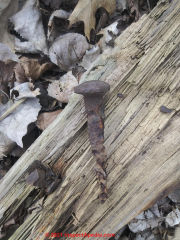
On 2020-10-07 by Stephen
On 2020-08-27 by (mod) - Duck-Billed nails?
You're referring to nails that were hand-wrought or modified to have a more-flat and wide tip that was then clinched over after being driven through two or more boards, forming a very secure connection.
More often you'll see the term "clinched nails" to describe nails whose tips were bent over. Earlier nails whose iron grains ran across the length of the shaft couldn't be clinched: they'd break off.
On 2020-08-27 by Dave
Have you heard of duck billed nails? My father in law showed me a handful years ago. The tips were flat for maybe 1/4 to 1/2 of an inch.
Used to make gates on the farm, once the tip came through two boards you were connecting together, you hammered the flat part over at a right angle.
So you didn't worry how much came through because you could just bend it over. I haven't been able to find any info on them.
On 2020-06-06 - by (mod) - Hand wrought style" machine made cut nail?
Nadine
That's certainly reasonable. Finding old newspaper buried in the construction of buildings or tool boxes or other items is often a very helpful clue to the potential age. It would be great to see some photos of the toolbox and of the nail, you can post one photo per comment.
On 2020-06-04 by Nadine Gates
Hi. On this page you have an image of "Hand wrought style" machine made cut nail".
I have what I believe is an old wooden tool box that the lid was attached by a side dowel (missing and lid is now detached) and nailed together by this same kind of nail. This is only by seeing the nail head in some places on the corners
There is no dovetail joinery. There are partial pieces of an old newspaper from Newfoundland dated 1833. Would you say that this chest/box is from that time period based on the nails used?
Many thanks,
Nadine
On 2019-04-15 by Anonymous - how old is this nail?
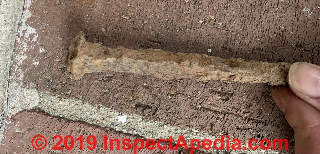 Re-posting a Q&A discussed by private email:
Re-posting a Q&A discussed by private email:
I’m trying to date this square nail. Looks hand made but there’s a lot of corrosion. Any information would be very much appreciated - Anonymous by private email
[Photo above]
Moderator reply:
Anon:
This nail is so corroded and exfoliated - expanding metal rust flakes - that I'm unsure of its profile and thus age.
I see some tapering just under the head. If that is from original fabrication and not an artifact of corrosion, then the nail may be hand wrought.
When someone asks for our opinion about the age of an apparently-antique hand wrought nail, cut nail, or other metal spike, and when the questioner offers no other information, it is difficult, perhaps impossible to answer.
Please see our new article NAIL AGE DETERMINATION KEY.
where we list questions that you can try to answer in order to form a reasonable guess about the probable age of the nail in your photo- shown below.
Let me know what you think after reviewing that article.
On 2018-12-27 by Shaun M. - antique hand-wrought nail was found near Rodman's Neck NY - The "Bronx Spike"
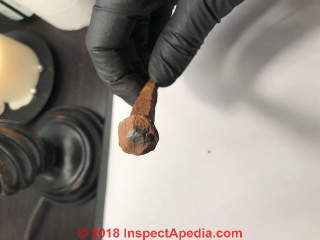 Yes, it was found in the Bronx NY on an old beach near Rodman's Neck.
Yes, it was found in the Bronx NY on an old beach near Rodman's Neck.
I know the Battle of Pell's Point (Revolutionary War battle) took place not to far from there as well.
British troops used this water way to make there way on to the island. But you think it's late 1800's?
On 2018-12-27 by (mod) -
That's certainly a hand-wrought spike.
In this photo the shank of the nail looks roughly square, not round as in Cat's earlier photos [later, below]- combined with hammer marks and irregularity and absence of cut nail edges, that's an argument for hand wrought.
A plausible guess is that your nail, found on the coast of New York (details?) dates from before 1880.
Take a look at NAILS & HARDWARE, AGE
On 2018-12-27 by Shaun M. - photos of antique spike from NY coast
Top of the spike [photo shown above]
Below: more photos of the Bronx Spike.
...
Was wondering if you cold help me identify the age of this Nail/Spike [photos above] It was found on an old beach about a foot below the sand.
All I know about it is is looks like its a hammered rose head.
The site use to have a house from the late 1600's early 1700's not to far from where I found it.
It also was an part of an old water way that goods use to travel back and forth in NY.
...
Continue reading at NAIL ID & AGE: CUT NAILS, or select a topic from the closely-related articles below, or see the complete ARTICLE INDEX.
Or see these
Recommended Articles
- AGE of a BUILDING, HOW to DETERMINE - home
- DOOR HARDWARE AGE
- NAILS, AGE & HISTORY - home
- HORSESHOE & HORSESHOE NAIL AGE
- NAIL & HARDWARE, AGE RESEARCH
- NAIL & HARDWARE CLEAN-UP
- NAIL AGE DETERMINATION KEY - use this key to guess at the age of your nail or spike
- NAIL ID & AGE: CUT NAILS
- NAIL ID & AGE: HAND FORGED NAILS
- NAILS in BARTER & TRADE
- NAIL SPLITS & CRACKS vs AGE
- NAIL TYPE, ANTIQUE, IDENTIFICATION KEY
- RAILROAD SPIKES
- RAILROAD SPIKE AGE - CONTEXTUAL CLUES
- SAW & AXE CUTS, TOOL MARKS, AGE
- WINDOW HARDWARE AGE
Suggested citation for this web page
NAIL ID & AGE: HAND FORGED NAILS at InspectApedia.com - online encyclopedia of building & environmental inspection, testing, diagnosis, repair, & problem prevention advice.
Or see this
INDEX to RELATED ARTICLES: ARTICLE INDEX to BUILDING AGE
Or use the SEARCH BOX found below to Ask a Question or Search InspectApedia
Ask a Question or Search InspectApedia
Try the search box just below, or if you prefer, post a question or comment in the Comments box below and we will respond promptly.
Search the InspectApedia website
Note: appearance of your Comment below may be delayed: if your comment contains an image, photograph, web link, or text that looks to the software as if it might be a web link, your posting will appear after it has been approved by a moderator. Apologies for the delay.
Only one image can be added per comment but you can post as many comments, and therefore images, as you like.
You will not receive a notification when a response to your question has been posted.
Please bookmark this page to make it easy for you to check back for our response.
IF above you see "Comment Form is loading comments..." then COMMENT BOX - countable.ca / bawkbox.com IS NOT WORKING.
In any case you are welcome to send an email directly to us at InspectApedia.com at editor@inspectApedia.com
We'll reply to you directly. Please help us help you by noting, in your email, the URL of the InspectApedia page where you wanted to comment.
Citations & References
In addition to any citations in the article above, a full list is available on request.
- In addition to citations & references found in this article, see the research citations given at the end of the related articles found at our suggested
CONTINUE READING or RECOMMENDED ARTICLES.
- Carson, Dunlop & Associates Ltd., 120 Carlton Street Suite 407, Toronto ON M5A 4K2. Tel: (416) 964-9415 1-800-268-7070 Email: info@carsondunlop.com. Alan Carson is a past president of ASHI, the American Society of Home Inspectors.
Thanks to Alan Carson and Bob Dunlop, for permission for InspectAPedia to use text excerpts from The HOME REFERENCE BOOK - the Encyclopedia of Homes and to use illustrations from The ILLUSTRATED HOME .
Carson Dunlop Associates provides extensive home inspection education and report writing material. In gratitude we provide links to tsome Carson Dunlop Associates products and services.


